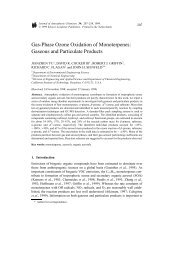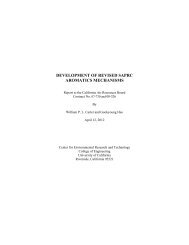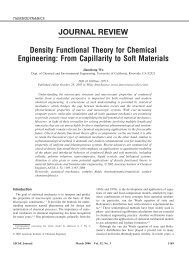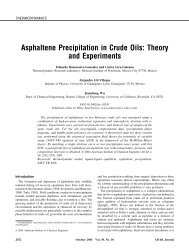State-of-the-Art Chamber Facility for Studying Atmospheric Aerosol ...
State-of-the-Art Chamber Facility for Studying Atmospheric Aerosol ...
State-of-the-Art Chamber Facility for Studying Atmospheric Aerosol ...
You also want an ePaper? Increase the reach of your titles
YUMPU automatically turns print PDFs into web optimized ePapers that Google loves.
TABLE 1. Instrumentation Summary<br />
instrument<br />
measures<br />
LDL/<br />
range<br />
accuracy<br />
flow<br />
rate<br />
(LPM)<br />
dedicated/<br />
alternating<br />
gas chromatograph reactive organic gas (ROG) 1 ppb a 2% 0.4 alternating<br />
flame ionization detector HP 5890 series II<br />
chemiluminescent NO x analyzer NO, NO 2 5 ppb 7% 0.7 alternating<br />
Thermoenvironmental Instruments Model 42<br />
ozone ozone 1 ppb 4% 1.0 alternating<br />
Dasibi Environemental<br />
hygrometer (capicatance probe) temperature 5-95% 0.50% c alternating<br />
Vaisala HMP 233 relative humidity -20 °C to50°C 0.1 °C<br />
condensation particle counter TSI 3010 CPC volume concentration 0.01 particles/cm 3 1% d 1.0 dedicated<br />
scanning electrical mobility size distribution and 25-700 nm b 0.3% e 2.75 dedicated<br />
spectrometer number concentration 1% e<br />
tandem differential mobility analyzer hygroscopic growth factor 1.003 (0.003 e 2.75 alternating<br />
portable spectroradiometer Licor - 1800 light spectrum 280-850 nm 0.1 nm N/A N/A<br />
gas chromatograph mass spectrometer<br />
HP GCD<br />
ROG/gas-phase oxidation<br />
products<br />
1 ppt a 5% 5.0 dedicated<br />
a<br />
Will be a function <strong>of</strong> hydrocarbon. b As currently configured. c In series with ozone and NO x instruments. d 500-30 000 cm -3 as configured.<br />
e<br />
Measured precision.<br />
FIGURE 1.<br />
Absorption spectrum <strong>for</strong> 2 mil FEP Teflon film.<br />
FIGURE 3. Light spectrum <strong>of</strong> Sylvania 350BL lights from Carter et<br />
al. (1). Solid line represents Sylvania 350BL; dashed line is solar<br />
light intensity at zenith angle ) 0; dotted line is solar light intensity<br />
at zenith angle ) 60. All three plots are normalized to have <strong>the</strong><br />
same integrated NO 2 photolysis rate.<br />
FIGURE 2. Block diagram <strong>of</strong> gas- and aerosol-phase instrumentation.<br />
*<br />
Tekmar refers to a Tenax-TA sampling tube which is later introduced<br />
to a GCD via a <strong>the</strong>rmal desorption system.<br />
sheeting (reflectance > 95%) covers all four walls, <strong>the</strong> ceiling,<br />
and <strong>the</strong> floor <strong>of</strong> <strong>the</strong> enclosure.<br />
A Licor 1800 portable spectroradiometer is used to monitor<br />
<strong>the</strong> light spectrum emitted by <strong>the</strong> blacklights. The photolysis<br />
rate <strong>of</strong> NO 2 is estimated by steady-state actinometry, in which<br />
NO 2 is injected into a clean chamber and irradiated, and <strong>the</strong><br />
resulting NO, NO 2, and ozone mixing ratios are measured.<br />
The photolysis rate constant, k 1, is <strong>the</strong>n estimated as k 1 )<br />
k 3[O 3][NO]/[NO 2] where [O 3], [NO], and [NO 2] are concentrations<br />
and k 3 (cm 3 /molecule/min) is <strong>the</strong> rate constant <strong>of</strong><br />
NO and ozone reaction. The measured k 1 value (corrected<br />
<strong>for</strong> dark ozone plus NO reaction in <strong>the</strong> sampling lines) in <strong>the</strong><br />
chamber at full light intensity is 1.5 min -1 , about three times<br />
that <strong>of</strong> natural sunlight at Pasadena, CA at a solar zenith<br />
angle <strong>of</strong> 0° on a clear day.<br />
The artificial light produced by <strong>the</strong> blacklights is not<br />
representative <strong>of</strong> <strong>the</strong> entire ground-level solar light spectrum.<br />
A comparison <strong>of</strong> <strong>the</strong> relative light intensity <strong>of</strong> a typical<br />
fluorescent blacklight to ground-level solar radiation is given<br />
in Figure 3 (1). The ultraviolet irradiation produced by <strong>the</strong><br />
blacklight lamps corresponds to <strong>the</strong> wavelengths <strong>for</strong> maximum<br />
NO 2 photolysis. However, <strong>the</strong> longer wavelengths that<br />
photolyze some organic compounds such as methyl glyoxal,<br />
in <strong>the</strong> range <strong>of</strong> 450-550 nm, are not emitted by <strong>the</strong> blacklight<br />
lamps. An extensive discussion <strong>of</strong> light sources and absorption<br />
cross sections <strong>for</strong> aldehydes and carbonyls is found in<br />
Carter et al. (1). Table 1 <strong>of</strong> Carter et. al (1) shows <strong>the</strong> relative<br />
rate <strong>of</strong> photolysis <strong>for</strong> several photolyzing species in <strong>the</strong><br />
chamber when comparing blacklights to solar radiation. The<br />
blacklights used in <strong>the</strong> Caltech chamber are <strong>the</strong> same as<br />
those described in Carter et. al (1). It is important to note<br />
that <strong>the</strong> irradiation produced by blacklight lamps varies with<br />
manufacturer.<br />
VOL. 35, NO. 12, 2001 / ENVIRONMENTAL SCIENCE & TECHNOLOGY 9 2595
















